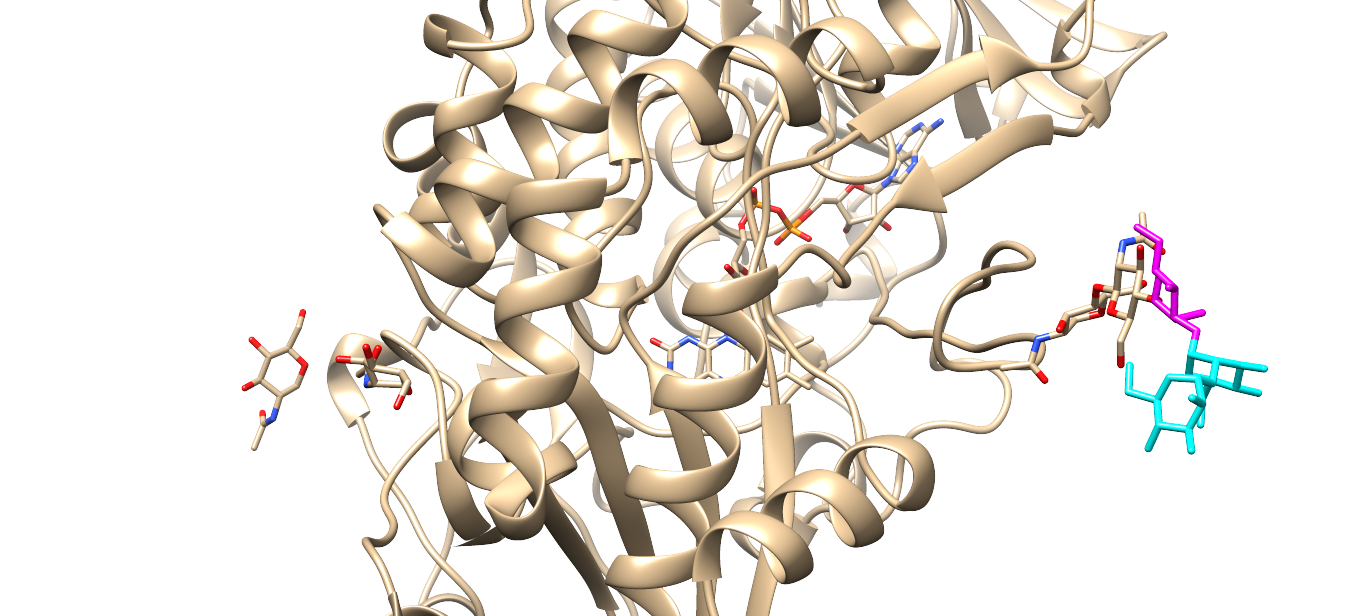Sandbox Reserved 1477
From Proteopedia
| Line 14: | Line 14: | ||
[[Image:MAN and BMA.png]] | [[Image:MAN and BMA.png]] | ||
Cyan part is a dimer of MAN (which is one of the reactants of the reaction this enzyme catalysts), magenta part is a BMA molecule. | Cyan part is a dimer of MAN (which is one of the reactants of the reaction this enzyme catalysts), magenta part is a BMA molecule. | ||
| - | <scene name='80/800656/ | + | Residues <scene name='80/800656/Asns/1'> Asn89, 161, 355 and 388</scene> (the residues in red) were highlighted by the author because of their interaction with the ligands. |
== Energetic == | == Energetic == | ||
Revision as of 19:13, 12 November 2018
| This Sandbox is Reserved from November 5 2018 through January 1, 2019 for use in the course "CHEM 4923: Senior Project taught by Christina R. Bourne at the University of Oklahoma, Norman, USA. This reservation includes Sandbox Reserved 1471 through Sandbox Reserved 1478. |
To get started:
More help: Help:Editing |
This page is reserved for Bo
Contents |
Default
This is a default text for your page '. Click above on edit this page' to modify. Be careful with the < and > signs. You may include any references to papers as in: the use of JSmol in Proteopedia [1] or to the article describing Jmol [2] to the rescue.
Introduction
The topic is going to be the structural study of the enzyme glucose oxidase from aspergillus niger. It is not an enzyme from human body. Instead, it is found in the cells of fungus. These types of enzymes catalysts the oxidation of beta-D-glucose to δ-gluconolactone and H2O2 (which is not a reaction happening in human body) [3]. I don't think there is any medical application for this certain enzyme since it is not even an enzyme from human body. The only possible medical application might be producing medicines with this type of reaction.
Two PDB codes mentioned by the essay, 1cf3 and 1gpe, which are two glucose oxidases from different organisms. They have exactly the same types of ligands, which might mean there is some functional issue with the present of those ligands, especially the dimer of beta-D-glucose (MAN). This essay was published back to 1999, which is fairly old in the scale of proteomic.
Function
 Cyan part is a dimer of MAN (which is one of the reactants of the reaction this enzyme catalysts), magenta part is a BMA molecule.
Residues (the residues in red) were highlighted by the author because of their interaction with the ligands.
Cyan part is a dimer of MAN (which is one of the reactants of the reaction this enzyme catalysts), magenta part is a BMA molecule.
Residues (the residues in red) were highlighted by the author because of their interaction with the ligands.
Energetic
Structural highlights
|
This is a sample scene created with SAT to by Group, and another to make of the protein. You can make your own scenes on SAT starting from scratch or loading and editing one of these sample scenes.
The structure of this enzyme contains only one chain with 4 different types of ligands. This is a 583-residue-long protein with the molecular weight of about 65.8kDa. The structure is tested by X-ray diffraction for the certain PDB entry with the code 1cf3. X-ray diffraction gives the information of the whole protein sequence (if the resolution of the instrument is high enough), which makes it better than any other methods with non-100% sequence courage. Another glucose oxidase also tested with X-ray diffraction method in the same essay from Penicillium Amagasakiense has two identical chains. As mentioned, they have exactly the same ligands, which actually make sense since they have the same function.
</StructureSection>
References
- ↑ Hanson, R. M., Prilusky, J., Renjian, Z., Nakane, T. and Sussman, J. L. (2013), JSmol and the Next-Generation Web-Based Representation of 3D Molecular Structure as Applied to Proteopedia. Isr. J. Chem., 53:207-216. doi:http://dx.doi.org/10.1002/ijch.201300024
- ↑ Herraez A. Biomolecules in the computer: Jmol to the rescue. Biochem Mol Biol Educ. 2006 Jul;34(4):255-61. doi: 10.1002/bmb.2006.494034042644. PMID:21638687 doi:10.1002/bmb.2006.494034042644
- ↑ Wohlfahrt G, Witt S, Hendle J, Schomburg D, Kalisz HM, Hecht HJ. 1.8 and 1.9 A resolution structures of the Penicillium amagasakiense and Aspergillus niger glucose oxidases as a basis for modelling substrate complexes. Acta Crystallogr D Biol Crystallogr. 1999 May;55(Pt 5):969-77. PMID:10216293
